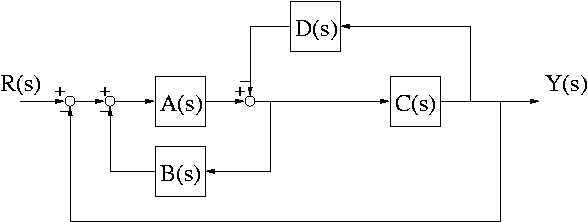- In the first model, the relationship among what the administration wants,
R(s), what the student body wants, W(s) and the
amount of freedom allowed by the rules governing student life, Y(s), is
illustrated by the following block diagram.

Since the administration recently had a very large step increase in the rules, they do not want any change. Thus, R(s)=0. The student body does not like the recent changes, so to increase freedom they propose that:

Use the final value theorem to compute the steady state value of y(t) where R(s)=0 and W(s)=1/s, as specified above.
- Enter the value you computed here: yss = (5 points)
- Use the step command in Matlab to verify that the value you computed is correct (and be sure to submit the plot). (5 points)
- In the second model, the administration uses
feedback by measuring Y(s) to determine what their response
will be, as illustrated in the following block diagram:
 ,
,where k=REPLACEq1. Again, use the final value theorem to compute the steady state value of y(t) for the same case where R(s)=0 and W(s)=1/s.
- Enter the value you computed here: yss = (5 points)
- Use the step command in Matlab to verify that the value you computed is correct. (5 points)
- Has adding feedback increased or decreased the effect of W(s) on the final value of y(t)? (increased/decreased) (5 points)
- The administration is very pleased with your brilliant work using the
feedback model. However, the student body has offered you a more attractive
compensation package for your services than the administration, so you have started working for them instead. What advice would you give to
the students in terms of changing the type or form of the input, W(s),
in order to have a greater effect on Y(s)? (5 points)
Determine the transfer function Y(s)/R(s) for the following block diagram. (20 points)

Enter the transfer function here (in a form like Y/R = (ABC)/(D+ABC)):
In order to receive any partial credit for an incorrect answer, be sure to submit sketches of any intermediate drawings and computations you have made to derive your answer.
Consider the following block diagram.

One coach desires that the rise time of the response of this system to a unit step input be less than 0.9 seconds and that the percentage overshoot be less than 5 percent. Hint: (s+10)(s+11)(s2+2s+2) = s4+23s3+154s2+262s+220.
- Is it possible to achieve this using proportional control, i.e., D(s) = k? (10
points)
Enter yes or no:
Be sure to submit any plots and/or computations to justify your answer.
- Design a lead compensator to meet or exceed these performance
specifications (to exceed the specifications, you will want a
lower rise time and percentage overshoot).
- Enter the location of the zero of the lead compensator here: (5 points)
- Enter the location of the pole of the lead compensator here: (5 points)
- Enter a value of the compensator gain (the K value) that meets or exceeds the performance specifications here: (10 points)
- Submit a root locus plot which illustrates that your compensator achieves the desired objectives (10 points).
- Assumed you were asked to design a lag compensator so that the steady state error to a step
was reduced by a factor of 10. Choose a location for the pole and zero
of a lag compensator that would accomplish this. Do not actually compute ess for this system -- just say where you would put the compensator pole and zero.
- Enter the location of the zero of the lag compensator here: (5 points)
- Enter the location of the pole of the lag compensator here: (5 points)